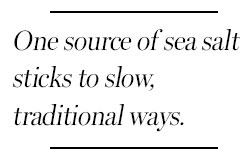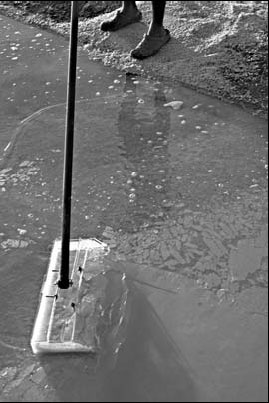Magic measured in a pile of salt
Updated: 2012-09-23 08:00
(The New York Times)
|
|||||||||
|
On Ile de Re, salt is cultivated by hand using a skimmer. Damien Lafargue for The New York Times |
ILE DE RE, France - Every afternoon, when the weather is right on this island off the west coast of France, the evaporation of the water in the artificial ponds causes the tiniest of salt particles to rise to the top.
By early evening, they form shiny, lace-edged crusts that look like ice. This is fleur de sel, the creme de la creme of salt, so delicate it must be harvested swiftly; the humidity of night or a sudden wind gust could destroy it.
On Ile de Re, every grain, every crystal of its most famous agricultural product, salt, is harvested by hand and marketed pure and unrefined.
Even more intriguing are the sauniers, the salt harvesters, working in what nearly two centuries ago Balzac described as "those melancholy swamps where the salt is made."
Their world revolves around the whims of the weather. The combination of a hot sun and a soft dry wind is needed to cause the perfect level of evaporation in the shallow, rectangular clay ponds whose water level they control with a system of pipes leading to the sea.
It is a world away from the global sea-salt business that has exploded in recent years.

Industrial sea salt is produced in vast quantities on the Mediterranean coast with steam shovels and conveyor belts; new enterprises have sprung up as far away as the shores of Chile and Mauritius.
But, for purists, nothing compares to sea salt hand-harvested from the northern French coastal area of Guerande, in Brittany. Guerande produces five times more salt than Ile de Re and has built a sophisticated marketing and export empire that stretches around the globe.
Last March, after a 15-year campaign, the salt producers of Guerande were awarded "protected geographical indication" by the European Union, giving them the exclusive right to the name "salt of Guerande." It is the first time that such a distinction has been given to a European salt.
Guerande is great, its quality control and marketing impeccable, its training center admirable.
But it is not my world. And after years of looking at salt as a consumer, I wanted to get close to the source.
That's how I found myself one evening with Emmanuel Mercier, a three-meter pole attached to a Plexiglas skimmer in my hand. In front of us were dozens of rectangular clay ponds topped with thin crusts of salt.
Mr. Mercier, who is 39, started out as a salt salesman. He fell in love with his product and moved his family here 12 years ago so that he could make it himself. He is now the president of the Cooperative of Sauniers of Ile de Re, which dries, inspects, stores, packages and markets both fleur de sel and gros sel for 50 of its members. (Gros sel is coarse gray salt.)
So it wasn't surprising that he was dressed rather conservatively, in a fresh white T-shirt with the cooperative's logo and shorts that reached his knees.
In the morning, Mr. Mercier had been out harvesting gros sel, and small piles of the salt left over from his harvest sat on the banks of the ponds.
Mr. Mercier let me taste the crystals and they burst open in my mouth with the taste of the sea and of minerals like magnesium, iron, potassium and zinc. Who knew that salt could be so sweet, not at all bitter? I understood why this salt is mostly used on the table as a finishing touch, rarely in the kitchen during cooking.
Fleur de sel is often served in a small pot with a spoon for sprinkling. But the salt can feel moist or dry, soft or hard, with grains of slightly different sizes and shapes. Pinching the shiny crystals and feeling the contrast between your fingers is part of the pleasure.

Mr. Mercier set his skimmer at the edge of a salt crust just below the surface of the water, moved it evenly in a line through the crust to pull up the salt, held it above the pond until most of the water drained out, then dumped the salt into a wheelbarrow. He repeated the movements again and again.
It took a few tries before I got the hang of it. When I set the skimmer too deep, it disturbed the clay bottom; too high and some of the crust broke free and disappeared below. It's not easy on the back.
"You have to be Zen here," Mr. Mercier said as he worked the marshes.
Not all of the island's salt harvesters belong to the cooperative. I confess that I buy my salt cheap from Viviane Baneletti, one of the independent rebels.
Ms. Baneletti, 63, has maintained her salt pools and harvested, packaged and sold salt on her own ever since her husband died three years ago after 32 years in the salt-harvesting business.
"Independent means just that," she said. "I make what I want, when I want. No one controls my product."
I buy gros sel here for as little as 1 euro (about $1.25) a kilogram, and the much rarer fleur de sel for as little as 10 euros a kilo. I'm also a sucker for her gimmicky mixtures of gros sel with herbs, spices, even algae. This year she mixed fleur de sel with ground Espelette chile pepper.
I end up going back to Paris each year with shopping bags full of her salt.
The New York Times
(China Daily 09/23/2012 page10)
